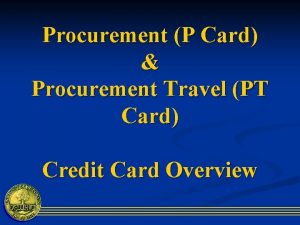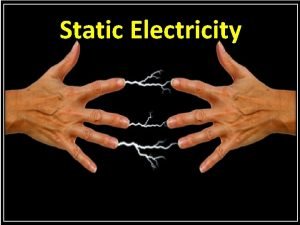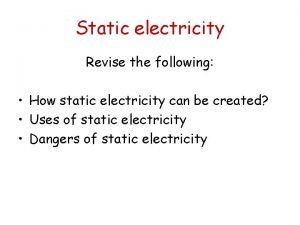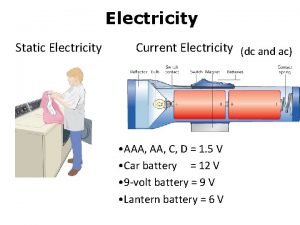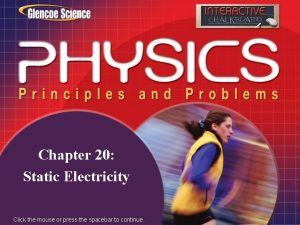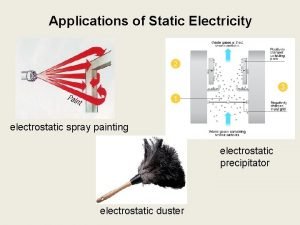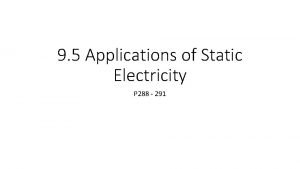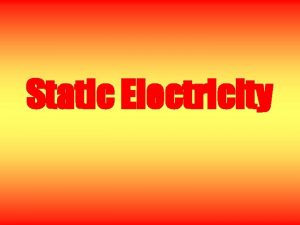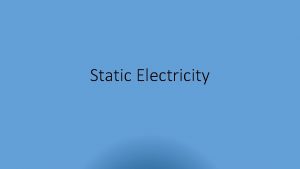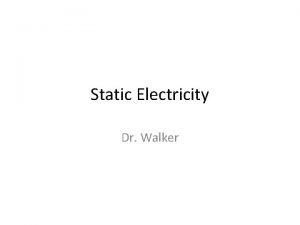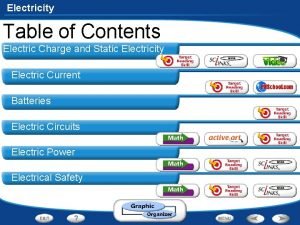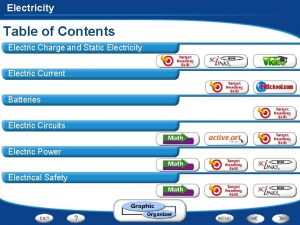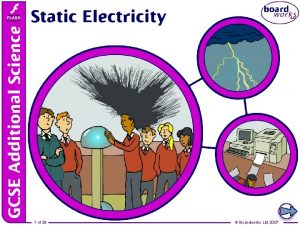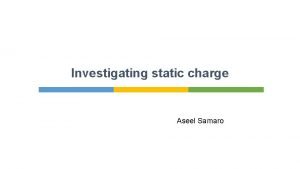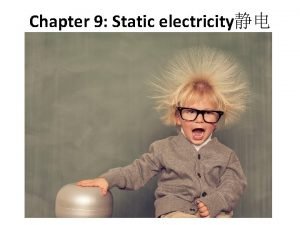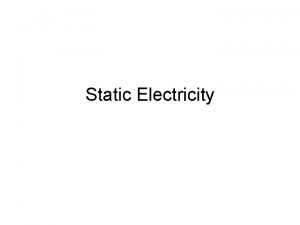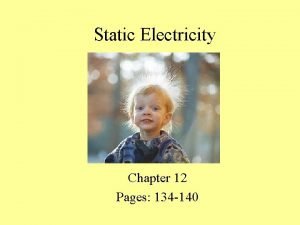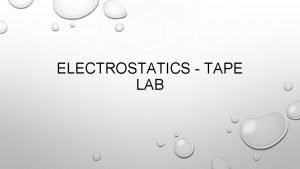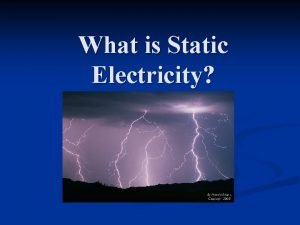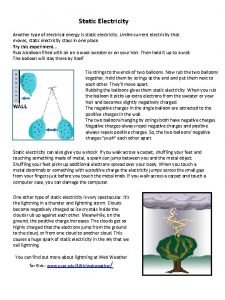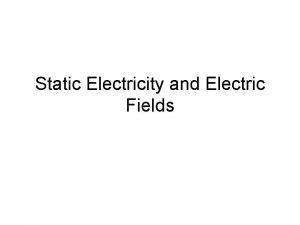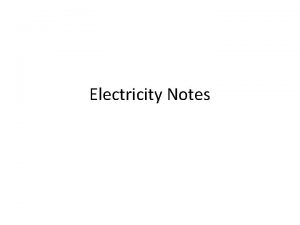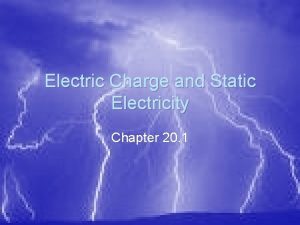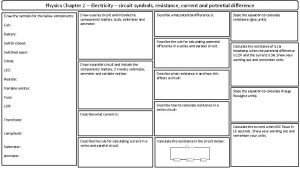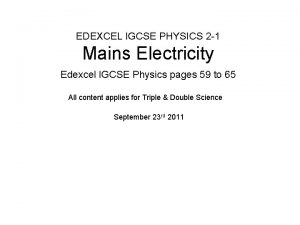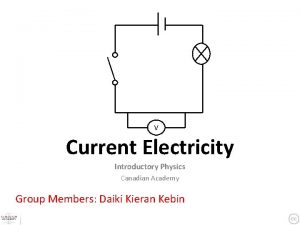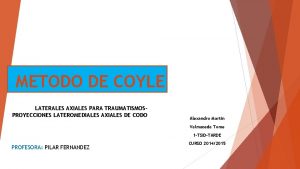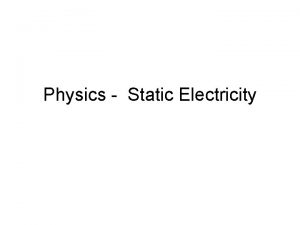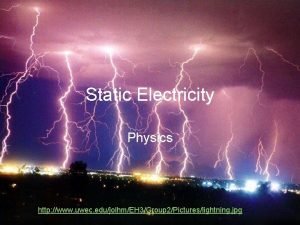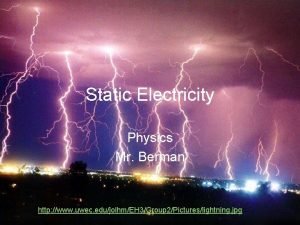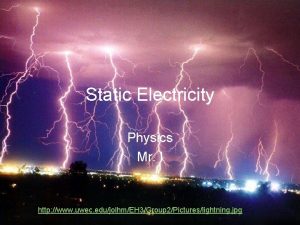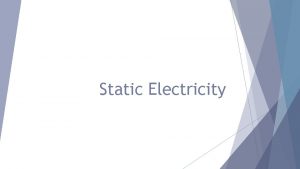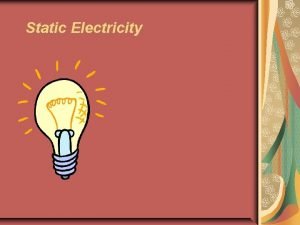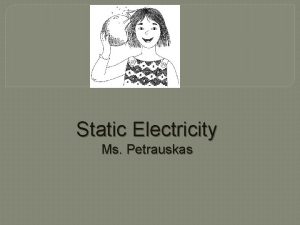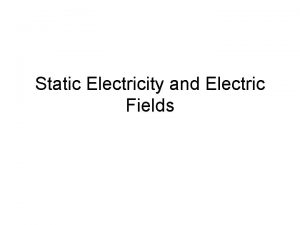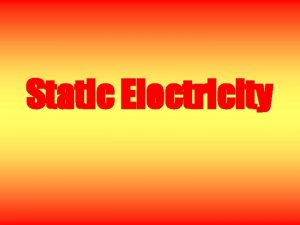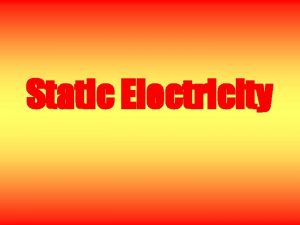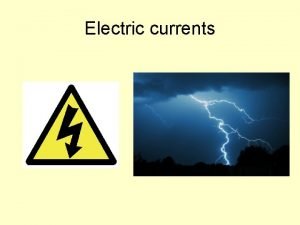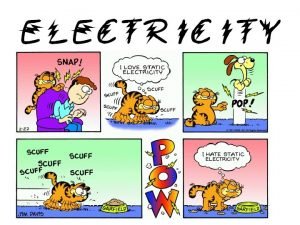Static Electricity Physics Mrs Coyle http www uwec









































- Slides: 41

Static Electricity Physics Mrs. Coyle http: //www. uwec. edu/jolhm/EH 3/Group 2/Pictures/lightning. jpg

Part I • • History Charge and its Conservation Conductors, Semiconductors, Insulators Methods of Charging

History • Electron means “amber” in Greek • Thales of Miletos 600 BC discovered properties by Greek. • He rubbed amber (mineral) with cat fur and attracted feathers.

Ben Franklin’s Kite Experiment (1740’s)

Leyden Jar

Benjamin Franklin • 1740’s lightning experiment with kite, key and Leyden jar (stores static electricity). • Franklin developed the lightning rod. • Proposed conservation of charge. • Saw electricity as a flowing fluid and called the flow direction positive.

Law of Conservation of Electrical Charge • The net charge of an isolated system remains constant.

Example: • An object of +10 C touched an identical object that was neutral. What is the charge of each object?

Law of Charges • Like charges repel • Opposite charges attract

J(oseph) J(ohn) Thomson (1897, England) • He discovered the electron. • He found that the mass of the electron is about 1/1800 of the mass of a hydrogen atom. • He won the Nobel Prize (1906) for his discovery of the electron.

JJ Thomson with the CRT

Cathode Ray Tube

Cathode Ray

Electrical Charge • Symbol: q • Unit : Coulomb, C

Charge and Mass of the Electron • Charge of Electron: 1. 6 x 10 -19 C (Coulombs) • Mass of Electron: 9. 11 x 10 -31 kg.


Positively charged objects lost electrons. Example: Rubbing a glass rod with silk. • Rod becomes + (loses electrons) • Silk becomes - (gains electrons).

Negatively charged objects have gained electrons. Example: rubbing a rubber rod with fur. • Rubber Rod: - charged • Fur: + charged

Note • Negatively charged objects have more mass than an identical neutral object, since each extra electron has a mass of 9. 11 x 10 -31 kg.

Types of Materials in terms of Electrical Conductivity • Conductors (metals) • Semiconductors (germanium, silicon) • Insulators (wood, glass, rubber)

Electrostatic Charging Methods • Friction • Conduction • Induction

Charging by Friction • The two objects wind up with opposite charges.

Triboelectric Series + Fur (rabbit) Glass Wool Fur (cat) Lead Silk Human skin, Aluminum Cotton Wood Amber Nickel, Copper, Brass, Gold Rubber Sulfur - Celluloid

Charging by Conduction (direct contact) • The objects end up with the same type charge. • If the charges are equal in size, they share the charge equally. http: //www. ap. smu. ca/demonstrations/index. php? option=com_content&view=article&id=106&Itemid=85

Charging by Induction • Objects ends up with opposite charge. • Involves grounding. http: //www. physics. sjsu. edu/becker/physics 51/elec_charge. htm

Electroscopes are used to test the charge of an object.

When a charged object is brought near the electroscope, its leaves spread apart. http: //upload. wikimedia. org/wikipedia/commons/e/ec/Electroscope_showing_induction. png

When a charged object touches an electroscope, the electroscope is now charged.

What was the charge of the object that touched this electroscope?

Polarization http: //www. csiro. au/helix/sciencemail/activities/Water. Bend. html

Part II • Coulomb’s Law

Coulomb’s Law • 1785, Charles Augustin Coulomb (French scientist) F = k q 1 q 2 ______ d 2 9 Nm 2/C 2 k = 9 x 10 • • d (or r): distance between the charges. • q : charge of each object.

The Direction of the Electrical Force

Coulomb’s Law is an Inverse Square Law http: //web. ncf. ca/ch 865/graphics/Coulomb. jpeg

The electrical force is one of the four fundamental forces.

Comparison with Gravitational Force • What are 3 differences between the electrical force and the gravitational force?

Comparison with Gravitational Force • What are 3 differences between the electrical force and the gravitational force?

Example 1 • A charge of 2 m. C is 0. 5 m from a charge of 3 m. C. Find the electric force.

Example 2 • Three charges are positioned as shown. Find the force acting on the 2 C charge.

Example 2 • Three charges are positioned as shown. Find the force acting on the 2 C charge.

Example 3 Two equal charges are located 1 m from each other. The force acting between them is 2 N. How many Coulombs is each charge? Answer: 15μC
 Static electricity and current electricity
Static electricity and current electricity Static electricity and current electricity
Static electricity and current electricity How are static electricity and current electricity alike
How are static electricity and current electricity alike Eform uwec
Eform uwec Uwec student health
Uwec student health Uwec study abroad
Uwec study abroad They are mrs garcia and mrs castro
They are mrs garcia and mrs castro They are mrs garcia and mrs castro
They are mrs garcia and mrs castro Mrs. darling was ___________ of mrs. s.
Mrs. darling was ___________ of mrs. s. Electricity flow
Electricity flow Static electricity painting
Static electricity painting Bill nye friction worksheet
Bill nye friction worksheet What year was electricity invented
What year was electricity invented Electric current
Electric current Difference between charge and electric charge
Difference between charge and electric charge Static electricity chapter 20 answers
Static electricity chapter 20 answers Spray paint static electricity
Spray paint static electricity Static electricity painting
Static electricity painting Static electricity.
Static electricity. Static electricity examples
Static electricity examples Which is greater
Which is greater Static electricity table
Static electricity table Graphic organizer electric current
Graphic organizer electric current Static electricity summary
Static electricity summary Does magnetic field exerts force on a static charge
Does magnetic field exerts force on a static charge Static electricity
Static electricity Static electricity
Static electricity Static electricity by calamityofcolors
Static electricity by calamityofcolors Static electricity tape lab
Static electricity tape lab Is cotton negatively charged
Is cotton negatively charged Static electricity one cloud to another
Static electricity one cloud to another Static electricity review
Static electricity review What is static electricity
What is static electricity The law of charges
The law of charges Static electricity by calamityofcolors
Static electricity by calamityofcolors Venn diagram of climate and weather
Venn diagram of climate and weather Physics 102 electricity and magnetism
Physics 102 electricity and magnetism Ib physics topic 5
Ib physics topic 5 Physics circuits symbols
Physics circuits symbols Mains electricity igcse physics
Mains electricity igcse physics What is current electricity in physics
What is current electricity in physics Metodo de coyle
Metodo de coyle



